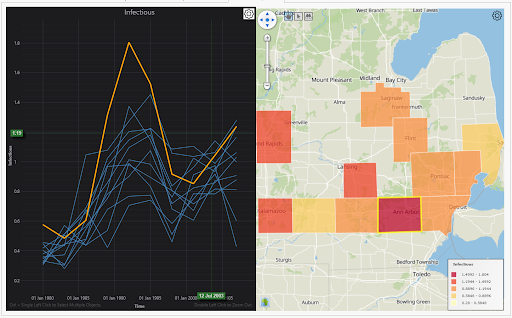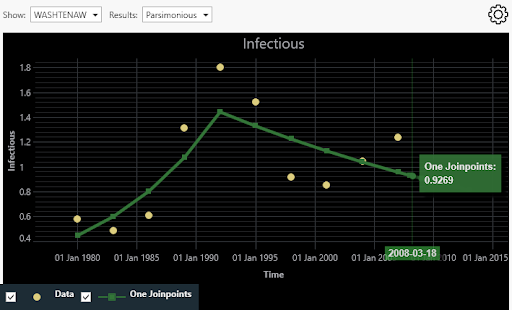We’re excited to announce the release of Vesta 2.8, the latest update to BioMedware’s premier software for spatial and temporal data analysis. Building on the major innovations we introduced in version 2.7, this update brings new features, refinements, and important fixes to make your work with Vesta even more powerful and seamless.
What’s New in Vesta 2.8
Future Predictions with Joinpoint Regression
Now, Vesta users can utilize joinpoint regression not only to analyze past and present trends, but also to predict future values. This upgrade enables users to more effectively allocate resources, assess risks, and prepare for what is to come. In addition, Joinpoint regression reports are now more visual, intuitive, and automatically displayed after an analysis.
Here is an example. Using the sample data set that is provided with Vesta 2.8 titled “Michigan Cause of Death 1979-2007”. Our team first created time plots of mortality due to infectious diseases, cancer, cardiovascular disease, and respiratory illness, shown below. You’ll notice the peak in infectious disease deaths in 1991-92. The image below highlights the curve for Washtenaw County.

It appears that mortality due to infectious diseases is increasing overall over time and is also increasing for Washtenaw County after the last displayed time point. Is this trend statistically significant? What happens if that trend continues? To answer this question, our team ran joinpoint regression in Version 2.8 (you can learn more about joinpoint regression here).

The newest release of Joinpoint Regression in Vesta 2.8 gave these results. Although all counties in the dataset were analyzed, the image above focuses on Washtenaw County.
Tabular results (not shown) found the joinpoint regression for Washtenaw County was significant, with one joinpoint in 1991-92 being the most parsimonious, meaning that it was best at explaining the observed time trends using the fewest model parameters. The model was used to predict future values past the last observation in 2007, out to 2013. The analysis found the peak in 1991-92 to be real; however, our hypothesized increase into the future was actually false, as the mortality forecast decreased beyond the end of the dataset.
But why? A major cause of infectious disease mortality in Washtenaw County appears to have been HIV-AIDS. With the advent of new treatments for HIV-AIDS in the mid-1990’s mortality dropped dramatically. Today, HIV-AIDS is a manageable illness, with long survivorship, that appears to be reflected in the forecast of a decreasing trend found by Vesta 2.8.
Machine Learning Regression
Machine learning regression now supports up to 6 covariates, which is perfect for more complex modeling. Why bother with Machine Learning (ML) methods? Because they can handle huge datasets and come with more complex models not supported in regular, non-ML methods. More data and more covariates mean increased modeling power, suited to the very large data streams coming from our increasingly connected world.
Create Workspaces From Anywhere
Launch new workspaces directly from any visualization dialog—flexibility at your fingertips. In earlier releases, users would exit the dialog to create a new workspace for displaying visualizations. This update means fewer clicks and navigation steps; the entire process is streamlined.
Smarter Data Panel
Newly created folders and variables are now automatically highlighted for better visibility. This means no searching for the results of your latest analysis; they are immediately displayed and highlighted for rapid inspection.
Enhanced Sample Projects
We’ve expanded sample projects to include multivariate seabed composition off the Canadian coast; the Flint drinking water crisis; temporal changes in late-stage breast cancer diagnosis; greenness index (NDVI) for the continental US; and causes of death in Michigan from 1979 through 2007. These projects are loaded directly into Vesta and include data and visualizations to get you started. Use these sample projects as templates to build your own datasets and analyses.
Enhanced Usability
We’ve gone over the entire user interface, including the data view, map legends, dialogs, and reporting. Whether you are a geospatial analysis maven or new to the world of geospatial analysis, you’ll find VESTA Release 2.8 to be intuitive, fun, and easy to use.
Why Upgrade Your GIS Software?
Vesta 2.8 is designed to make your research easier, faster, and more insightful. Whether you’re forecasting with joinpoint regression, working with complex models, or simply navigating your projects more efficiently, this release ensures you can focus on discovery rather than software.
Download the update today and see how Vesta 2.8 helps you analyze smarter, visualize better, and discover more relationships for formulating and testing hypotheses. Try it for free here!

